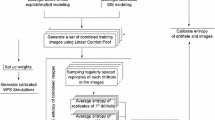Abstract
Selecting a training image (TI) that is representative of the target spatial phenomenon (reservoir, mineral deposit, soil type, etc.) is essential for an effective application of multiple-point statistics (MPS) simulation. It is often possible to narrow potential TIs to a general subset based on the available geological knowledge; however, this is largely subjective. A method is presented that compares the distribution of runs and the multiple-point density function from available exploration data and TIs. The difference in the MPS can be used to select the TI that is most representative of the data set. This tool may be applied to further narrow a suite of TIs for a more realistic model of spatial uncertainty. In addition, significant differences between the spatial statistics of local conditioning data and a TI may lead to artifacts in MPS. The utilization of this tool will identify contradictions between conditioning data and TIs. TI selection is demonstrated for a deepwater reservoir with 32 wells.












Similar content being viewed by others
References
Caers J., 2001, Geostatistical reservoir modeling using statistical pattern recognition: J. Petrol. Sci. Eng. 29(3):177–188
Caers J., Strebelle S., Payrazyan K., 2003, Stochastic integration of seismic data and geological scenarios: a West Africa submarine channel saga: The Leading Edge 22(3):192–196
Deutsch C. V., 1992, Annealing techniques applied to reservoir modeling and the integration of geological and engineering (Well Test) data. Stanford University, Stanford, 306 p (unpublished doctoral dissertation)
Guardiano, F., and Srivastava M., 1993, Multivariate geostatistics, beyond bivariate moments, in Soares, A., ed., Geostatistics Troia 1992, v. 1, p. 133–144
Harding, A., Strebelle, S., Levy, M., Thorne, J., Xie, D., Leigh, S., Preece, R., and Scamman, R., 2004, Reservoir facies modeling: New advances in MPS, in Leunangthong, O., and Deutsch, C. V., eds., Proceedings of the Seventh International Geostatistics Congress, Banff, Alberta, 10 p
Liu, Y., Harding, A., Abriel, W., Strebelle, S., 2004, Multiple-point statistics simulation integrating wells, seismic data and geology: Am. Assoc. Petrol. Geol. Bull. v. 88, no. 7, p. 905–921
Mood, A. M., 1940, The distribution theory of runs: Annal. Math. Stat. v. 11, no. 4, p. 367–392
Ortiz, J. M., Deutsch, C. V., 2004, Indicator simulation accounting for multiple point statistics: Math. Geol. v. 36, no. 5, p. 545–565
Pyrcz, M. J., and Strebelle, S., 2006, Event-based geostatistical modeling of deepwater systems, reservoir characterization: Integrating technology and business practices: Gulf coast section: SEPM Twenty-Sixth Annual Research Conference, p. 893–922
Pyrcz, M. J., Catuneanu, O., Deutsch, C. V., 2005, Stochastic surface-based modeling of turbidite lobes: Am. Assoc. Petrol. Geol. Bull. v. 89, no. 2, p. 177–191
Pyrcz, M. J., Boisvert, J. B., and Deutsch, C. V., 2007, A library of training images for fluvial and deepwater reservoirs and associated code: Comput. Geosci., doi: 10.1016/j.cageo.2007.05.015
Strebelle, S., 2002, Conditional simulation of complex geological structures using multiple-point statistics. Math. Geol. v. 34, no. 1, p. 1–22
Strebelle, S., Payrazyan, K., and Caers, J., 2002, Modeling of a deepwater turbidite reservoir conditional to seismic data using multiple-point geostatistics, in SPE Annual Conference and Technical Exhibition San Antonio, Soc. Petroleum Engineers Paper 77425, 10 p
Acknowledgment
We would like to thank Chevron for providing the 32-well data set used for testing.
Author information
Authors and Affiliations
Corresponding author
Rights and permissions
About this article
Cite this article
Boisvert, J.B., Pyrcz, M.J. & Deutsch, C.V. Multiple-Point Statistics for Training Image Selection. Nat Resour Res 16, 313–321 (2007). https://doi.org/10.1007/s11053-008-9058-9
Received:
Accepted:
Published:
Issue Date:
DOI: https://doi.org/10.1007/s11053-008-9058-9



